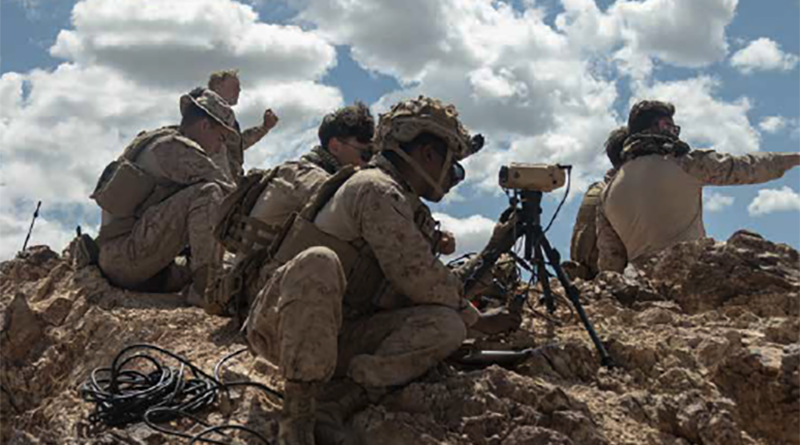Measured Response in a Millisecond World
The general stood at the edge of the observation deck, watching an attack unfold on the wall of monitors. Hyper.sonic blurs cut arcs across virtual skies, interceptors rose like reflexes from a sleeping giant, and data-events happening faster than thought.
And yet, beneath the hum of advanced tech, one question lingered like a distant storm cloud: Who decides to strike back when milliseconds matter?
As Publisher of COTS Journal, IÕve walked the corridors of in.novation long enough to know the difference between prog.ress and pretense. Artificial IntelligenceÑAIÑis no longer a lab experiment. It is the silent observer, the always-listening sentinel. And in the theater of military defense, it is rapidly becoming both shield and sword.
But here’s the uncomfortable truth: Many of today’s loudest voices on AI in the military are missing the point. Some are enchanted by AIÕs power to surveil, control, or even paci.fy civilian populations’ tools of oppression masquerading as innovation. Others focus solely on weaponization, envi.sioning autonomous machines waging wars beyond human reach.
That’s not the future I see.
For all its steel and fire, the military is, first and foremost, a human institution. It is governed by tradition, rank, and doc.trine forged through generations. This hierarchy is not a relicÑit is a safeguard. It ensures deliberation before escala.tion and control before chaos. And as battle plans grow ever more complex and threats arrive at speeds beyond compre.hension, that chain of command must endureÑeven if its next link is artificial.
So, how do we introduce AI into this sacred framework without unraveling it?
The answer is focus. Narrow, intentional focus. AI must not be handed the launch keys in a moment of fear or aggres.sion. Its role must be defensive by design, limited in scope, and rooted in one goal: to buy us time.
Consider this: A hypersonic missile traveling at Mach 5— more than a football field every 100 milliseconds. ThatÕs fast.er than the blink of a human eye. Faster than most ethernet packets. In such a moment, no general can call a meeting. No commander can consult a doctrine. The decision must be made before anyone knows a decision needs to be made.
That’s where AI earns its placeÑnot as a judge or execution.er, but as an early responder. A buffer between detection and decision. A sentry that sees the shadow of a strike and raises a shield before it’s too late.
Historically, our Anti-Ballistic Missile (ABM) systems gave us minutes of warning by tracking the arcs of ICBMs across the sky. But the age of long-lead threats is over. Today’s dangers come from stealthy submarines and mobile platforms, from missiles that alter course in flight and cross continents in minutes. There is no arc to followÑonly moments to act.
And yet, as we dream of a homeland defense system akin to IsraelÕs Iron Dome, reality sets in like a cold wind. The scale of such a system for the United States—landmass, population centers, geography—makes it nearly unimaginable. Alaska alone is 80 times the size of Israel. Should it be pro.tected equally? Is Los Angeles more valuable than New York? The cost could reach into the trillions—before we account for the requirement that all components be American-made or open-standard compliant.
What we envision, then, is not a dome but a mesh—a flexible, evolving network of sensors, interceptors, and AI-driv.en response nodes that work together, not in place of, but alongside, human leadership.
But while we defend against physical strikes, another war rages in silence.
Cyber conflict is the invisible battlefield of the modern age. Our defense infrastructure spans multiple branches, gener.ations of systems, and alliances that stretch across the globe. Every connection is a door. Every protocol has a potential weakness. Imagine every Bluetooth headset, every Wi-Fi link, and every firmware update in the field. Now multiply that vulnerability by a hundredfold. ThatÕs what the Depart.ment of Defense faces each day.
In such a chaotic ecosystem, AI becomes more than help.fulÑit becomes necessary. Not to police or dominate but to monitor, interpret, and warn. Like a sentinel posted at every gate, its role is not to act but to alert. It buys the time we no longer have and identifies the threat no human could parse fast enough.
So, no, AI in the military should not be feared as an overlord nor worshipped as a savior. It is neither. It is a tool—powerful, precise, and dangerous if misused.
And like every tool in the arsenal, it must be wielded with discipline, restraint, and above all—human judgment.

